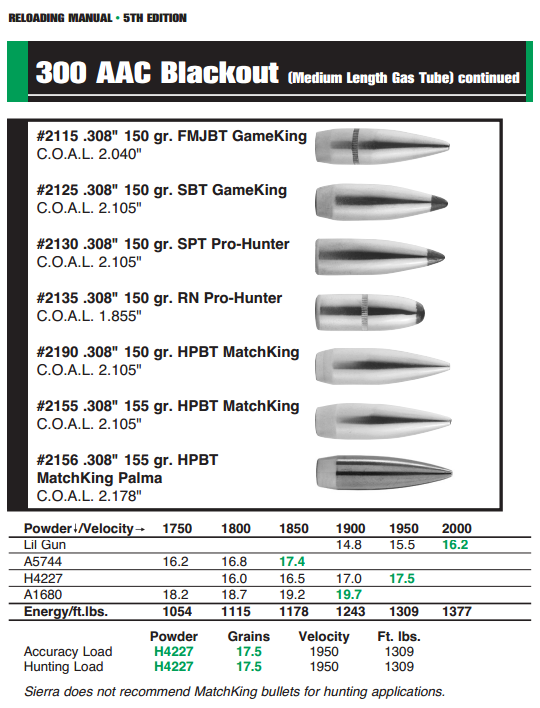March 15th, 2014
Now that Lapua is making very high-quality .221 Fireball brass, those of you who own an AR may be considering a 300 AAC Blackout project. For AR shooters, the 300 Blackout (300 BLK) offers the ability to fire a heavy-weight bullet from standard AR15 magazines. When loaded to supersonic velocities with heavy bullets, this little cartridge packs more punch than a 30-30 round. Alternatively, when loaded to sub-sonic velocities, the 300 Blackout is ultra-quiet when used with a suppressor.

Writing for the CTD Shooter’s Log, CTD Mike has authored a good Beginners’ Guide to the 300 AAC Blackout. This explains the basics of this interesting cartridge, which is a .30-caliber round that works with existing AR15 magazines and upper. You can purchase 300 Blackout factory ammunition or you can load your own. The easiest way to make 300 Blackout cartridges is to neck-up Lapua .221 Fireball brass. But if you have hordes of .223 Rem brass, you can also cut those cases down and reform them into 300 Blackout. But that is much more work. With Lapua .221 Fireball brass, you lube the inside of the necks, expand, and you’re good to go.

300 Blackout vs. 6.8 SPC
AR owners who have considered a dedicated upper in 6.8 SPC, should give serious consideration to 300 Blackout instead. First, with so much .223 Rem available, you have a virtually infinite supply of parent brass. 6.8 SPC brass is not so easy to find. Second, to function optimally, the 6.8 SPC requires dedicated magazines. CTD Mike says: “6.8 SPC II and 6.5 Grendel both require specific magazines [that are] different from the Standard NATO Agreement (STANAG) AR-15 magazine. These magazines are not nearly as common … and of course cost a bit more. On top of that, you lose capacity in those calibers, down to 25 rounds instead of 30, because their casings are fatter and take up more space[.]”
The Sound of Silence — Suppressed 300 Blackout Properties
The 300 AAC Blackout is a great option if you live in a jurisdiction that allows suppressor ownership. A suppressed 300 Blackout is ultra-quiet and very reliable. CTD Mike explains: “Unlike 5.56, subsonic [1000 FPS] loadings that still cycle the AR-15 action reliably are easy to make [with] a 220 grain .308 bullet. At close range, these 220 grain rounds really thump, and the real kicker is that using an AAC suppressor with them in a 9-inch barrel brings the sound level to only 125 decibels. That’s quieter than an MP5SD shooting 9mm rounds, and much quieter than a MK23 pistol shooting .45acp rounds. You have to be there and shoot one of these rifles with a ‘can’ attached to realize that this 220 grain bullet is nearly as quiet as a silenced .22 pistol.”
 AR15 Podcast Talks about 300 Blackout
AR15 Podcast Talks about 300 Blackout
If you are intrigued by the 300 AAC Blackout, you should consider listening to an hour-long AR15Podcast hosted by Reed Snyder and co-Host Anthony Hardy. In this Podcast, Reed explains how to re-barrel an AR15 for the 300 Blackout. Step by step, he explains how to remove your .223-caliber barrel and install a .30-caliber barrel chambered for the 300 Blackout. Reed lists the tools you’ll need and he also explains how to tune adjustable gas blocks for best performance with a 300 Blackout upper.
|
AUDIO FILE: AR15 Podcast about 300 AAC Blackout (Warning Loud Volume) |
For those who are undecided about adapting their AR15s for the 300 Blackout, Reed weighs the pros and cons of having a dedicated .30 caliber in your AR arsenal. Here are some of the strong points of this interesting cartridge:
- 300 Blackout cartridges fit and feed in standard AR magazines.
- 300 Blackout rivals 7.62x39mm performance.
- Brass and Bullets are readily available.
- Barrel is only part that needs to be modified.
- Excellent Subsonic Performance — very quiet.
- .30 Caliber suppressors can be used with smaller calibers as well.

About the 300 AAC Blackout (300 BLK)
The 300 AAC Blackout cartridge shares case-head dimensions and body taper with the .223 Remington. Not only does this allow for compatibility with existing magazines and bolts, but it allows reloaders to form their own brass from cut-down 5.56×45 mm or .223 Rem cases. You can also form 300 Blackout cases by necking-up .221 Fireball brass. Take Note: Lapua has started producing .221 Fireball brass — this should be available in the USA by the end of April.

The 300 AAC Blackout is a similar concept to previous wildcats, such as the 30-221 and 300 Fireball, as well as the proprietary 300 Whisper®, except that 300 BLK was the first to be a SAAMI-approved cartridge and any company is free to make firearms or ammunition.
300 AAC Blackout is also finding use with hunters, who may not have been able to legally hunt with .223 in their state, and who prefer .30 caliber bullets for medium-sized game. It provides similar effectiveness to the 7.62×39 or the slightly more powerful .30-30 cartridges except works in the more up-to-date AR-platform rifles. Effective hunting range is about 150 yards. Some innovators, such as Dave Whitford, have also experimented with the 300 BLK for Across-the-Course competition. READ Whitford story in Rifleman’s Journal..
Related RESOURCES:
American Rifleman Article with 300 AAC Blackout AND 300 Whisper Reamer Prints.
.330 AAC Blackout Factory Ammunition Review.




























